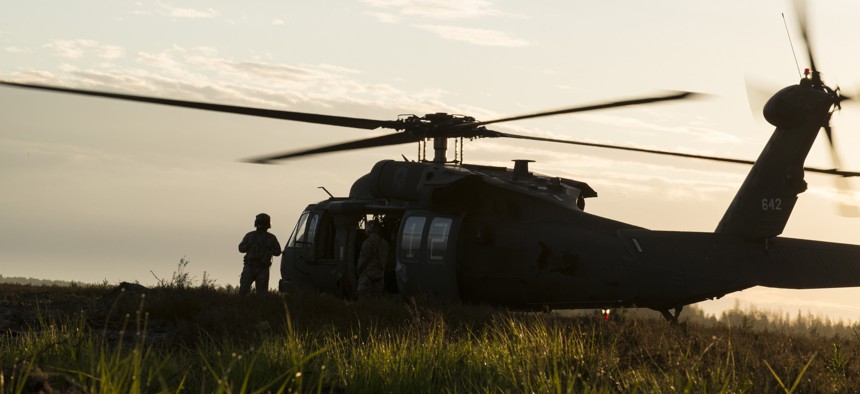
Sgt. Sara Marchus/U.S. Army National Guard
Three Things the US Military Needs to Fight in Europe
One year into rotational deployments on the continent, here’s what the Army and Marines say they need.
For the first time since the Cold War, the U.S. military is relearning what it would take to fight alongside its NATO allies on the European continent, and the soldiers and Marines who took part in the first year of rotational deployments have a few requests.
As part of U.S. efforts to reassure European allies and deter Russian aggression, the Army dispatched the 10th Mountain Division’s aviation brigade to Europe for nine months, and sent an armored brigade from the 4th Infantry Division to join NATO’s multinational Enhanced Forward Presence battle groups in Poland.
Also at the start of the year, about 300 U.S. Marines arrived in Norway to practice cold-weather fighting and stiffen the deterrence message; a second rotation replaced them this summer.
Marines in Norway and recently returned Army leaders say they’re excited about the level of cooperation they’ve reached with U.S. allies, and with the rigorous exercises that simulated a peer-to-peer conflict.
“I was very impressed with the willingness of our allies to allow us to train the way that we would fight, particularly in the Atlantic Resolve countries — they take it very seriously,” said Col. Clair Gill, the commander of the 10th Mountain Division's combat aviation brigade.
After 15 years of fighting in the comparatively uncontested deserts of the Middle East, everything from tactics to the physical environment offers new challenges and chances to learn, they said. They also listed a few items that they say U.S. forces need to fight a war in Europe:
Upgraded navigational systems
Even though just about everyone with a smartphone has access to GPS navigation, some of the Army’s Black Hawk helicopters do not. That turned out to be a problem in Europe.
“In the national airspace here in the United States, we have a lot of ground-based navigational aids that we use to fly when we’re in the clouds, when we’re in instrument conditions,” Gill said. “To fly in Europe, which is a satellite-based flying environment...we could only fly limited places that had ground-based capabilities."
He said they only discovered how much of a problem it would be once they arrived.
The Army used modernization funds to equip the deployed aircraft with a “temporary solution,” but a long-term program to upgrade all of the service’s helicopters is still in the works, Gill said.
Better boots and cold-weather gear
U.S. and NATO military officials are fond of saying that the Russians see their western edge as one contiguous theater. The Marines in the small town of Troendelag, Norway, are learning how to fight on that theater’s northernmost edges.
Lesson No. 1: “Cold isn’t something you can suck it up and fight; you have to learn to adapt,” one Marine said.
Part of that adaptation is about shifting tactics and procedures; another part is just having the right clothing and equipment. There’s a Norwegian saying: “There’s no bad weather, just bad clothing.” And it’s not that the U.S. Marines don’t have cold-weather gear, but it hasn’t been tested in such extremes in a long time.
Take the Marines’ boots — great for the cold weather the Corps has weathered for the last decade and a half in Afghanistan and elsewhere, not so much for the subzero temperatures of the Arctic Circle. Next to the Norwegians’ boots, one Marine in Troendelag said his footwear looks like “Mickey Mouse boots.”
In other cases, the Norwegian gear blows the American versions away. In at least one case, the U.S. Marines are renting a tent from the Norwegians to store equipment, because the Americans’ tents couldn’t withstand the winds.
The 330 Marines now in Troendelag are now slated to get some new gear after talking with leadership earlier this year, but those lessons must percolate all the way up through the chain of command to be of any real long-term benefit to the Corps, according to reservist and Arctic security analyst Lindsay Rodman.
Vehicle certifications
To drive across Europe’s internal borders, cars and trucks laden with hazardous materials must comply with a longstanding, regularly updated safety certification process called the ADR. U.S. Army vehicles don’t.
“Certain vehicles carrying hazardous materials must be modified — at a significant cost and time — to comply with European ADR requirements,” Gill said.
That’s not just an inconvenience. It literally makes realistic training for a potential war on the continent impossible — and it might well hinder an actual wartime movement. A large part of what the Army is learning from these rotational deployments to Europe is what it would take to get forces to the frontlines if a war broke out — Gill had his entire aviation brigade test just that, driving 1,300 miles to one multinational exercise.
As with the navigational systems in the aviation brigade’s Black Hawks, the Army now has a quick fix in place for the units rotating through the continent. The service is still working on turning this into a standard part of vehicle certification, so troops under fire in a European war aren’t left without air support, artillery, or other critical capabilities.
Army Materiel Command “developed a solution where they can get the vehicles certified here in the States before they go, and as an enterprise solution in the long term, the Army’s looking to certify all of its hazardous-carrying vehicles to comply with what is becoming an international standard,” Gill said.




